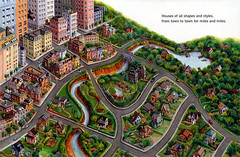One story buildings are a waste of urbanity
(Flickr photo of H Street Connection, DC by Inked78.)
A couple weeks ago at a meeting, a city official recounted the discussion from a community meeting in Ward 7, where the people were demanding retail, including the built form, more like Cleveland Park.
(Cleveland Park's commercial district was built mostly in the 1930s and is one story. But that was a different time where the value of land was much less. Plus, the area has plenty of very large apartment buildings, which adds a great deal of population to the retail trade area.)
The great urban design columnist for the Toronto Star, Christopher Hume, has a piece, "City sleeps as single-storey stores creep," about how how single story buildings should not be allowed in the city.
This makes sense too from the standpoint of the Transect as outlined by Andres Duany and others.

Illustration from The House Book by Keith DuQuet

New Urban Transect
We fought very hard against the fake 2 story building at the corner of 8th and H Streets NE--the new building replaced 4 eligible for historic designation buildings of 2 and 3 stories each.
We lost. The DC Department of Housing and Community Development, at least at that time, wasn't much concerned with the impact of a building on a commercial district overall.

Then again, another example of a wasted opportunity to extend urbanity and the connection to transit is the shopping center now called Rhode Island Place.

Once such projects are built, it is at least 20 to 40 years before you get another opportunity to start over and do what should have been done from the outset.




0 Comments:
Post a Comment
<< Home